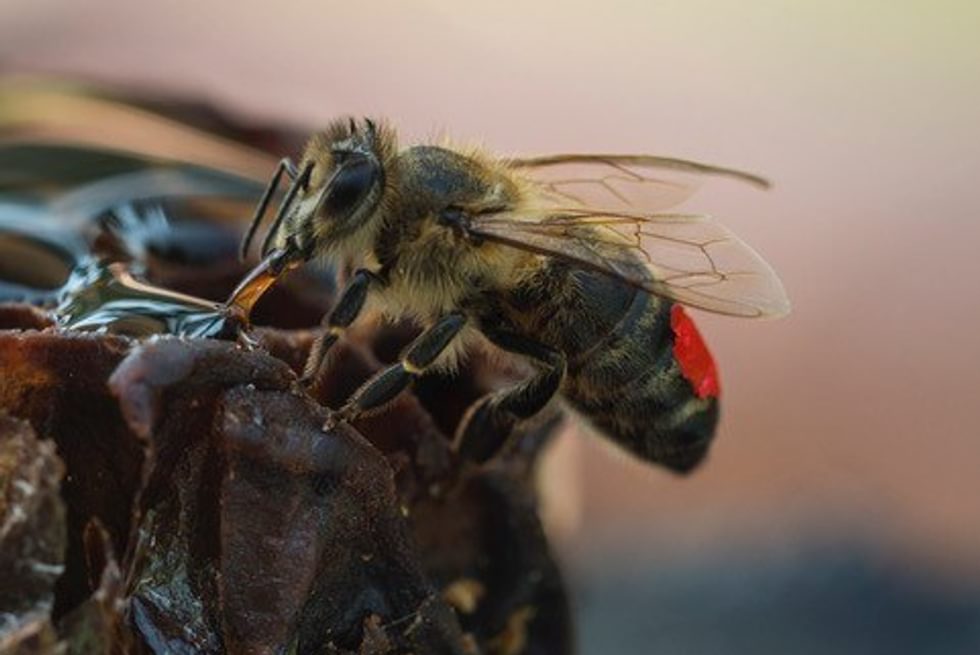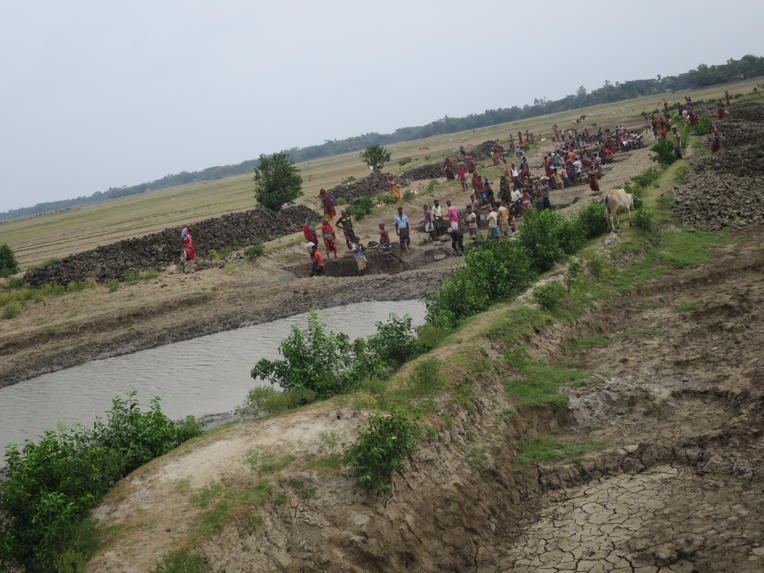Caring for Dying Canals
From the Series: Multispecies Care in the Sixth Extinction
From the Series: Multispecies Care in the Sixth Extinction

Nodi (pseudonym) is a place surrounded by water: the freshwater tributary river of the Ganges and a tidal brackish river originating from the Bay of Bengal. It is a floodplain in Bangladesh’s southwest coastal region, covered a century ago by mangroves. Along Nodi’s edges runs a large seawall constructed in the 1960s to prevent floods and increase agricultural productivity. In total, four thousand kilometers of these permanent structures were constructed alongside rivers as part of the Coastal Embankment Project funded by USAID. The embankments cut hundreds of canals from their riverine sources and have resulted in canals and rivers filling up with silt. While the deep and wide Bhadra River once divided Nodi into two parts with steamboats passing through it, today it is no more than a canal. Nitesh, a landless day laborer, told me, “The Bhadra River is now the Dead Bhadra (Mora Bhadra). The canals filled up with silt and died . . . We can no longer catch fish from the canals or irrigate our crops.”
The people of Nodi mourned the many mora khal (dead canals) where there had once been deep bodies of water connecting the river to the fields. When free from silt, these bodies of water flow through the delta and are filled with a multitude of living beings, such as freshwater fishes, shrimp, crabs, and eels flowing with the tides. When deep and wide, canals retain the life-giving freshwater rains of the monsoon such that farmers can take these stored waters and use them in their fields, bringing the different forms of life within these ecological assemblages into the paddy wetlands. Canals are vital commons for rural livelihoods in Bangladesh, not just for irrigation, but also for catching freshwater aquatic species for household food consumption. In Nodi, children loved swimming and playing in these waters. When these canals silted up and died, the livelihoods of coastal people, fish and plants deteriorated with them. Caring for canals means to remove the silt that is choking them, care that became essential as “flood-protection” embankments resulted in causing siltation.

Rishi Kaka, an 85-year-old farmer, described how during his childhood local people made aushtomashi bandhs (eight-month embankments): small, temporary earthen levees after the harvest of rice in mid-January to protect against saline incursion from the Bay of Bengal during the dry season. In mid-August, they removed the bandhs along the various canals connected to the river to facilitate monsoon borsha floods of rain mixed with sediment-laden river water to irrigate paddy fields. This dynamic system adapted to the active flows of the delta prevented saltwater intrusion in the dry season, while enabling irrigation in the monsoon season. Furthermore, the floods, or inundated wetlands, provided breeding grounds for hundreds of spawning fish species. The silt in these waters further raised land levels while also promoting processes of organic decomposition, making the deltaic lands fertile.
However, the permanent embankment built in the 1960s (see Figure 2) stopped all floods, including the beneficial monsoon flood. Bangladesh is situated in a hydrologically active delta where each year its three main rivers carry one billion tons of sediment across it. “Flood-protection” embankments, by preventing the rivers from flooding the plains, also prevented the sediment from depositing on the lands (raising them), instead filling up rivers and canals with silt, slowly causing them to become mora (dead). Now the silt raises riverbed levels, making the land inside the embankment lower than that on the outside, congesting water drainage in the monsoon and damaging rice fields.

The sad reality of the coastal zone is thus the silting up of rivers, while flood risks are exacerbated by the very embankments made to stop them (Auerbach et al. 2015). Nevertheless, donors such as the World Bank and the government of the Netherlands are both proposing “flood-protection” embankments as climate change adaptation infrastructure for Bangladesh’s coastal zone, thus misreading climate change in this region by proposing that climate change is causing floods (Dewan, in press).
Caring for bodies of water in Bangladesh means helping them to flow, allowing them to flood the plains, or it can mean removing silt. In 2015 the World Food Programme’s climate change adaptation project excavated major canals in Nodi that had silted up across the embanked floodplain. The project hired two to three hundred people to excavate large canals, providing income opportunities for local families, including landless day-laboring single mothers without husbands.

Caring for the canal through removing the silt resulted in widened and deepened canals with greater capacity to absorb and store water from the monsoon rains for the dry season. The project was highly valued by the people of Nodi as deeper canals helped Nodi reconnect to its surrounding rivers. Such practices of care go beyond what an individual or a small community can do by themselves. This sort of care is infrastructural and embedded in wider politics of water management.
Top-down, universalizing attempts to control nature, such as that of flood-protection embankments, have imposed permanent structures on a dynamic delta made, and remade, out of silt and water. Such embankments cause these bodies of water to silt up and die, threatening the multiple species living in, and through, them. Coastal populations hope for the health of rivers and canals that bring both “the rice and fish that make a Bengali” (an old proverb). Yet, such care is obstructed by a political landscape where maintenance of the delta is underprioritized and underfunded. Caring for canals through hiring local people to excavate them is a model that much of the silting, moribund delta would benefit from; indeed, more such care could give us hope for the survival of such ecological assemblages of bodies of water, humans, and more-than-humans during the Sixth Extinction. Caring for a riverine ecosystem thus extends the concept of care beyond that across specific species, highlighting how humans must also care for fluidscapes hosting multiple forms of life.
Barnes, Jessica, and Samer Alatout. 2012. “Water Worlds: Introduction to the Special Issue of Social Studies of Science.” Social Studies of Science 42, no. 4: 483–88.
Dewan, Camelia. In press. Misreading Climate Change: How Development Has Failed Environment and Society in Coastal Bangladesh. Seattle: University of Washington Press.